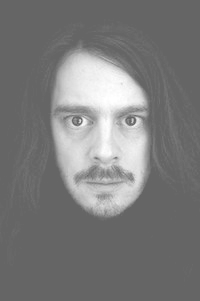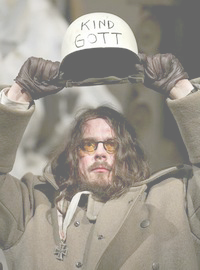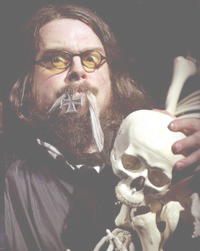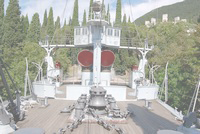Livestream
Home
JONATHAN MEESE
GRAILSBABY D’ANNUNZIOZ
Vittoriale degli Italiani, Gardone, Italy
5 June 2009, 7 pm
Radioperformance
DON LOLLYTADZIOZ Metabolismys does not stink (FART)
Livestream www.dannunzioz.org
6 June till 5 July 2009
AHAB says: MOBY DICK is NO DEMOCRACY, soon ALL DEMOCRATS will sit NO MORE in one BOAT (The Battleship of ART will never sink)
Installation on the Puglia in the garden of the Vittoriale
Under patronage of Giordano Bruno Guerri (president of the Vittoriale degli Italiani)
JONATHAN MEESE
GRAILSBABY D’ANNUNZIOZ
Vittoriale degli Italiani, Gardone, Italy
5 June 2009, 7 pm
Radioperformance
DON LOLLYTADZIOZ Metabolismys does not stink (FART)
Livestream www.dannunzioz.org
6 June till 5 July 2009
AHAB says: MOBY DICK is NO DEMOCRACY, soon ALL DEMOCRATS will sit NO MORE in one BOAT (The Battleship of ART will never sink)
Installation on the Puglia in the garden of the Vittoriale
Under patronage of Giordano Bruno Guerri (president of the Vittoriale degli Italiani)

Project
One hundred years ago Filippo Tommaso Marinetti announced the arrival of Futurism and his desire for art to lead and govern the people. In the same year the Nobel prize in physics was given to Guglielmo Marconi for the invention of wireless telegraphy. Ten years later Gabriele d’Annunzio realised this desire, if only for a moment, creating the first leadership of art, an artist run state in the town of Fiume (now Rijeka). Gabriele D’Annunzio and Guglielmo Marconi, the most famous Italians of their time, broadcast from the yacht Elettra a revolutionary radio message to the world, which is still in the ether: ALALÁ
Grailsbaby D’Annunzioz was able to establish this leadership of art only for a short moment, but anticipating the total dictatorship of art that will come inevitably. In his radio message DON LOLLYTADZIOZ Metabolismys does not stink (FART) Jonathan Meese will send this ultra extreme message not only to the 53rd Venice Biennale, but to the whole world: SWEETIESSWETTIESSWETTIES
One hundred years ago Filippo Tommaso Marinetti announced the arrival of Futurism and his desire for art to lead and govern the people. In the same year the Nobel prize in physics was given to Guglielmo Marconi for the invention of wireless telegraphy. Ten years later Gabriele d’Annunzio realised this desire, if only for a moment, creating the first leadership of art, an artist run state in the town of Fiume (now Rijeka). Gabriele D’Annunzio and Guglielmo Marconi, the most famous Italians of their time, broadcast from the yacht Elettra a revolutionary radio message to the world, which is still in the ether: ALALÁ
Grailsbaby D’Annunzioz was able to establish this leadership of art only for a short moment, but anticipating the total dictatorship of art that will come inevitably. In his radio message DON LOLLYTADZIOZ Metabolismys does not stink (FART) Jonathan Meese will send this ultra extreme message not only to the 53rd Venice Biennale, but to the whole world: SWEETIESSWETTIESSWETTIES
Meese
“The donation of power will be the most celebrated thing, the day of the ultimate takeover will come.”
SWETTIESSWETTIESSWETTIES
Jonathan Meese 2008 in his Berlin state speech

DICTATORSHIP OF ART. Since 2006 Jonathan Meese has been making propaganda for the dictatorship of art. The party of this dictatorship is named art. Under the domination of art there will be no more mean domination of man. Total humbleness is the name of this new world order, which will be established on the day zero, after the takeover of art – which will be in fact a donation of power. The volcano will erupt, there is no alternative – no power of man, no creativity, no soul – only neutrality. Only “art” as “total leadership” is anti-nostalgic, revolutionary and loving. Soon there will be only one land in the world, named the land of erz (Erzland). Playing without rituals is the only possible way for artist and man to achieve the dictatorship of art.

RADIOTRANSMITTER AND INSTALLATION. According to the example of D’Annunzio Jonathan Meese will broadcast the dictatorship of art in 2009. For this purpose there is no better place than the Puglia in the Vittoriale degli Italiani. For Meese theatres and exhibition halls are shelters, command centres, from which one could make propaganda for the hermetic revolution. From the bridge, the former command centre on the Puglia, Jonathan Meese will push his peaceful revolution of art. The dictatorship of art flies a flag on the Puglia, furthermore big and small skeletons in the rig and bow of the Puglia will remind of the legionnaires of Fiume. Skeletons, here meant as crew of a ghost ship, are part of the repertoire of Meese’s installations and always refer to the fact, that for Meese the human soul is outside.

FLYER CAMPAIGN. In summer 2008, fifty years after the poet’s death, from a two seater flyers were thrown on Gardone to remember D’Annunzio’s famous flight over Vienna. In 2009 this operation should be re-enacted – this time with flyers of the dictatorship of art. If possible such flyers should be thrown on the Venice Giardini too.

“The donation of power will be the most celebrated thing, the day of the ultimate takeover will come.”
SWETTIESSWETTIESSWETTIES
Jonathan Meese 2008 in his Berlin state speech

DICTATORSHIP OF ART. Since 2006 Jonathan Meese has been making propaganda for the dictatorship of art. The party of this dictatorship is named art. Under the domination of art there will be no more mean domination of man. Total humbleness is the name of this new world order, which will be established on the day zero, after the takeover of art – which will be in fact a donation of power. The volcano will erupt, there is no alternative – no power of man, no creativity, no soul – only neutrality. Only “art” as “total leadership” is anti-nostalgic, revolutionary and loving. Soon there will be only one land in the world, named the land of erz (Erzland). Playing without rituals is the only possible way for artist and man to achieve the dictatorship of art.

RADIOTRANSMITTER AND INSTALLATION. According to the example of D’Annunzio Jonathan Meese will broadcast the dictatorship of art in 2009. For this purpose there is no better place than the Puglia in the Vittoriale degli Italiani. For Meese theatres and exhibition halls are shelters, command centres, from which one could make propaganda for the hermetic revolution. From the bridge, the former command centre on the Puglia, Jonathan Meese will push his peaceful revolution of art. The dictatorship of art flies a flag on the Puglia, furthermore big and small skeletons in the rig and bow of the Puglia will remind of the legionnaires of Fiume. Skeletons, here meant as crew of a ghost ship, are part of the repertoire of Meese’s installations and always refer to the fact, that for Meese the human soul is outside.

FLYER CAMPAIGN. In summer 2008, fifty years after the poet’s death, from a two seater flyers were thrown on Gardone to remember D’Annunzio’s famous flight over Vienna. In 2009 this operation should be re-enacted – this time with flyers of the dictatorship of art. If possible such flyers should be thrown on the Venice Giardini too.

D’Annunzio
“In todays crazy and cowardly world there is a sign of liberty, in this crazy and cowardly world there is an immaculate thing: Fiume. There is only one truth: and that is Fiume; there is only one love: and that is Fiume! Fiume is the brilliant lighthouse, the light that shines so bright amidst the sea of perfidy.”
ALALÁ Gabriele D’Annunzio 1919 in his speech after the capture of Fiume

FIUME. In September 1919 Italian poet Gabriele D’Annunzio captured the Istrian seaport Fiume, todays Rijeka, at that time a city with 50 000 habitants and an occupation army of 10 000 men. For the first time in history one dream of the avant-garde came true: art was in power and the endless calls and words were finally fulfilled. This first “dictatorship of art” lasted for only 15 months. The concessions, which had to be made to politics after World War One, were too massive and, ultimately, the project proved itself to be too exceptional and the memories of Fiume faded. In the quotation of D’Annunzio, one could easily replace the word “Fiume” by “art”, and outside of Italy the domination of art was, to a large extent, brushed aside or repressed.

VITTORIALE. “After so much noise I’m longing for calmness, and after so much war for peace. ” After the shipwreck of the dictatorship of art commandant Gabriele D’Annunzio moved to Lake Garda and bought a mansion, the germ cell of the later Vittoriale degli Italiani. In the meantime the fascist movement used the myths of Fiume wrongly to prepare a coup d’état. For D’Annunzio “adolescent imitators” and an “illegitimate takeover”. Mussolini’s March on Rome was not the march on Ronchi and for D’Annunzio an illegal takeover. D’Annunzio retreats into his “shell” and henceforth avoids the field of politics. The Vittoriale turns into a monument for World War One and the days of Fiume – with the aircraft, from which he threw flyers on Vienna, the torpedo boat MAS, from which not torpedoes but a message in a bottle was sent to the Austrian armed forces, and the bow of the royal cruiser Puglia as the main parts of this solemn orchestration. On the “hill of death”, built after the poets death, some legionnaires, the architect of the Vittoriale, Gian Carlo Maroni, and D’Annunzio himself are resting. Their remains were buried in Roman sarcophagi.



PUGLIA. The bow of the royal cruiser Puglia came to Gardone in the beginning of 1925 boxed in 20 railway cars and was transported to the Vittoriale. Even Guy Debord praises the bow, which was set into the hills of the mountain, in one of his texts as a felicitous example of misappropriation, in the sense of the Sitationist International.

RADIO. In 1920 Guglielmo Marconi the inventor of the radio came to Fiume to built a radio transmitter there. The plan failed but D’Annunzio sent a short radio message form Marconi’s yacht. The script and the recording of this message are archived in the Vittoriale and the Luce-Institute in Rome.

“In todays crazy and cowardly world there is a sign of liberty, in this crazy and cowardly world there is an immaculate thing: Fiume. There is only one truth: and that is Fiume; there is only one love: and that is Fiume! Fiume is the brilliant lighthouse, the light that shines so bright amidst the sea of perfidy.”
ALALÁ Gabriele D’Annunzio 1919 in his speech after the capture of Fiume

FIUME. In September 1919 Italian poet Gabriele D’Annunzio captured the Istrian seaport Fiume, todays Rijeka, at that time a city with 50 000 habitants and an occupation army of 10 000 men. For the first time in history one dream of the avant-garde came true: art was in power and the endless calls and words were finally fulfilled. This first “dictatorship of art” lasted for only 15 months. The concessions, which had to be made to politics after World War One, were too massive and, ultimately, the project proved itself to be too exceptional and the memories of Fiume faded. In the quotation of D’Annunzio, one could easily replace the word “Fiume” by “art”, and outside of Italy the domination of art was, to a large extent, brushed aside or repressed.

VITTORIALE. “After so much noise I’m longing for calmness, and after so much war for peace. ” After the shipwreck of the dictatorship of art commandant Gabriele D’Annunzio moved to Lake Garda and bought a mansion, the germ cell of the later Vittoriale degli Italiani. In the meantime the fascist movement used the myths of Fiume wrongly to prepare a coup d’état. For D’Annunzio “adolescent imitators” and an “illegitimate takeover”. Mussolini’s March on Rome was not the march on Ronchi and for D’Annunzio an illegal takeover. D’Annunzio retreats into his “shell” and henceforth avoids the field of politics. The Vittoriale turns into a monument for World War One and the days of Fiume – with the aircraft, from which he threw flyers on Vienna, the torpedo boat MAS, from which not torpedoes but a message in a bottle was sent to the Austrian armed forces, and the bow of the royal cruiser Puglia as the main parts of this solemn orchestration. On the “hill of death”, built after the poets death, some legionnaires, the architect of the Vittoriale, Gian Carlo Maroni, and D’Annunzio himself are resting. Their remains were buried in Roman sarcophagi.



PUGLIA. The bow of the royal cruiser Puglia came to Gardone in the beginning of 1925 boxed in 20 railway cars and was transported to the Vittoriale. Even Guy Debord praises the bow, which was set into the hills of the mountain, in one of his texts as a felicitous example of misappropriation, in the sense of the Sitationist International.

RADIO. In 1920 Guglielmo Marconi the inventor of the radio came to Fiume to built a radio transmitter there. The plan failed but D’Annunzio sent a short radio message form Marconi’s yacht. The script and the recording of this message are archived in the Vittoriale and the Luce-Institute in Rome.
